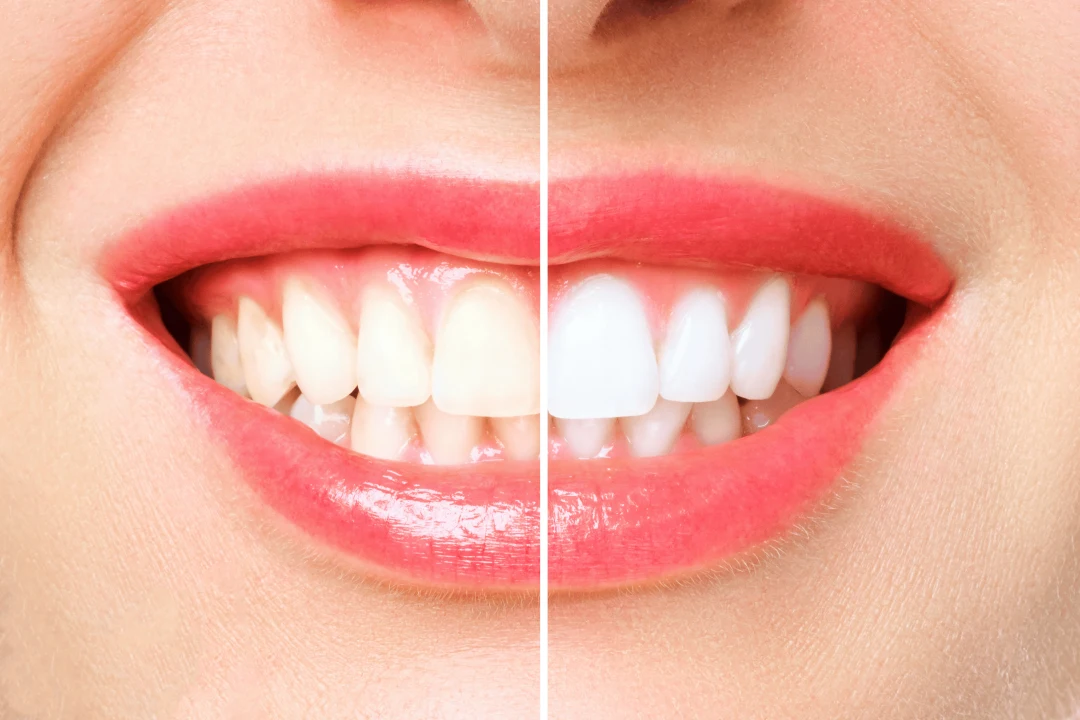Teeth Whitening
Our teeth may get stained or discoloured over time for a number of reasons.
Food and Beverages
Regular consumption of coffee, tea, red wine, and certain fruits can stain the enamel of your teeth.
Tobacco Use
Smoking or chewing tobacco can lead to stubborn tooth stains that are difficult to remove.
Poor Oral Hygiene
Inadequate brushing and flossing can allow plaque and tartar buildup, leading to tooth discoloration.
Age
As we become older, the protective enamel coating on our teeth falls away naturally, exposing the whitish dentin below.
Medication and Illness
Certain medications, such as antibiotics or chemotherapy drugs, can cause tooth discoloration. Additionally, some illnesses and medical treatments may also result in changes in the color of your teeth.

Causes of Tooth Discoloration
Extrinsic Stains
These stains originate on the surface of the teeth and are often caused by consuming stain-inducing foods and beverages such as coffee, tea, red wine, and certain spices.
Intrinsic Stains
Intrinsic discoloration occurs within the tooth structure itself and can result from factors such as aging, genetics, trauma, and certain medications.
Types of Teeth Whitening
In-Clinic Teeth Whitening
Performed by a dental professional, in-Clinic teeth whitening involves applying a highly concentrated bleaching gel to the teeth. Special lights or lasers may be used to enhance the bleaching process. This method offers fast and noticeable results.
At-Home Teeth Whitening
At-home teeth whitening involves using custom-made trays and a milder bleaching gel provided by your dentist. You'll wear the trays for a specified period each day over the course of several weeks, gradually achieving desired results.
Over-the-Counter Products
Over-the-counter teeth whitening products include whitening toothpaste, strips, and gels. While these options are convenient, they generally offer more gradual results and may not be as effective as professional treatments.
The Teeth Whitening Process
Initial Consultation
Before undergoing teeth whitening, it's important to consult a dental professional. Your dentist will evaluate your oral health and discuss your desired outcomes to determine the most suitable whitening method for you.
Professional In-Clinic Whitening
Preparation
Your dentist will protect your gums and lips, applying a barrier to prevent any contact with the bleaching gel.
Bleaching Gel Application
The concentrated bleaching gel is applied to your teeth. Special lights or lasers may be used to activate the gel, enhancing its effectiveness.
Multiple Sessions
In-Clinic whitening may involve multiple sessions, each lasting around 15 to 30 minutes. Your dentist will monitor the progress and adjust the treatment as needed.
At-Home Whitening
Impressions
Your dentist will take impressions of your teeth to create custom-fitted trays that ensure even application of the bleaching gel.
Instructions
You'll be provided with the trays, bleaching gel, and detailed instructions on how to use them at home. Follow the dentist's recommendations for duration and frequency.
Gradual Progress
Results from at-home whitening become noticeable over a few weeks as you consistently use the trays and gel as directed.
Benefits of Teeth Whitening
- Enhanced Appearance : Teeth whitening significantly improves the appearance of your smile, boosting your self-esteem and confidence.
- Youthful Radiance Whiter teeth can take years off your appearance, contributing to a more youthful and vibrant look.
- Improved Oral Hygiene Undergoing teeth whitening often prompts individuals to maintain better oral hygiene practices, extending the benefits of the procedure.
- Post-Whitening Care
- Maintain Good Oral Hygiene
- Brush your teeth twice a day and floss daily to prevent new stains from forming.
- Limit Stain-Inducing Foods and Beverages
- Reduce your consumption of coffee, tea, red wine, and other foods and drinks that can stain your teeth.
Regular Dental Checkups
Scheduling routine dental visits ensures your teeth remain healthy and that the results of your teeth whitening are maintained.
Teeth whitening is a remarkable journey towards a brighter, more confident smile. From professional in-office treatments to at-home solutions, teeth whitening offers a range of options to suit your preferences and needs. Consult a reputable dental hospital to explore the best teeth whitening method for you and achieve the stunning smile you’ve always desired.
